
After being sardined in the train in Tokyo en route to the shinkansen, it was a relief to arrive in Kyoto, where we were able to check in to our Aoi Kyoto Stay machiya.

First stop in Kyoto: Aoi Kyoto Stay Hotel, to check into our converted machiya, down the canal-side street, Kiyamachi-dori
This was our our 3rd time staying in their charming converted townhouses, this time in Manjuji-bashi, on the same delightful canal as our prior stays.
We were a little further south this time, convenient for this trip, since we’d need be meeting up with the group some mornings at the Hyatt Regency.
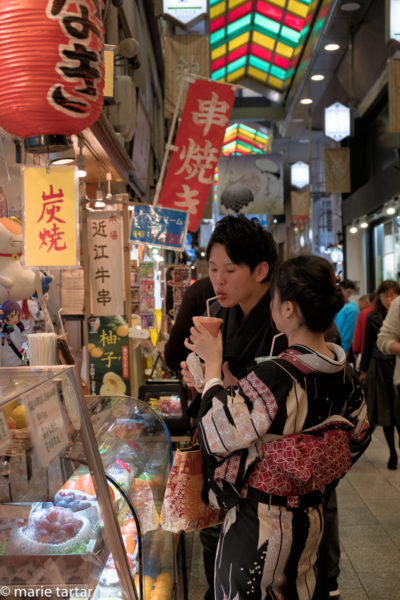
One reason I love staying on Kiyamachi-dori, besides the canal, river proximity and cherry trees, easy walking distance to Nishiki Market, Kyoto’s kitchen
We walked through Nishiki Market, stocking up on sake and sembei crackers, en route to gyoza and ramen favorite west of the market, Ippudo. I had the autumn special, which had me moaning, it was so scrumptuous. Afterwards, it was time to slowly head east, back through the market, over to the Gion Kaikan Theater for Gion Odori. This dance performance (odori means dance and Gion is the geisha district) is presented each fall from November 1-10, with the theme changing each year. Our seats were in the rafters, but it was still a transporting, hypnotic experience.

Kimono detail, in Gion, Kyoto; dressing up in kimono for outings to temples has become a big thing in Japan
Afterwards, it was time to slowly head east, back through the market, over to the Gion Kaikan Theater for Gion Odori. This dance performance (odori means dance and Gion is the geisha district) is presented each fall from November 1-10, with the theme changing each year. Our seats were in the rafters, but it was still a transporting, hypnotic experience.
Zoraida needed study time to complete a history class assignment, so she decamped to a Starbucks, while we walked Gary through some of our favorite local shooting streets, including Shimbashi and Ponto-cho.
We had a corner of one the the large tables at Kiln (me in my customary spot), for an enjoyable dinner of salad with feta and pear, risotto with duck and grilled vegetables.
Tuesday, November 8, 2016
(Almost election day) It had been a relief to be away from the furor of the US presidential election. We were all acutely aware of the high stakes of the election, which was beginning hours later. Our like-minded group had been joking a lot about not returning home, if the election went awry. I personally had never previously feared the outcome of an election, but this cycle had been exceptionally disturbing.
Our day was an exceptionally eventful and pleasant one. It was rainy and foggy, pleasantly cool. Steve and I walked through Kawai Kanjiro’s neighborhood to meet up with the group at the Hyatt Regency, about 20 minutes away by foot. Today was dedicated to ceramics, and we had an authority to guide us, a San Diego hometown boy, Robert Yellin, to guide us. We know Robert through our Japanese contemporary ceramics collector friend Gordon, and we have dedicated portions of two prior trips to excursions to his traditional Japanese home and gallery.
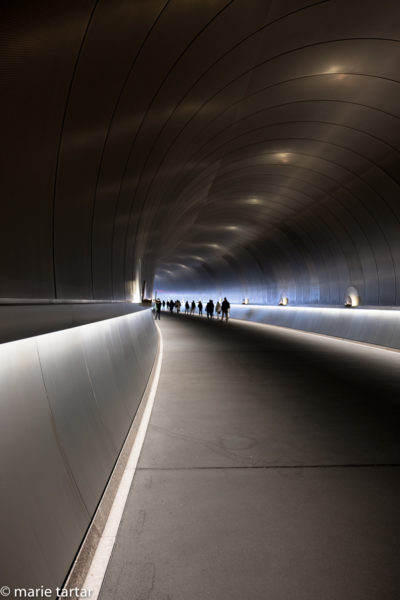
The amazing, transporting tunnel approach to the Miho Museum by I.M.Pei, outside Kyoto; the transit through the tunnel is said to be based on a Chinese tale, “Peach Blossom Valley” in which a fisherman arriving at a blooming peach orchard sees a light at the foot of a mountain beyond and journeys through a cave to arrive at Shangri-La
We had been to our first stop, the Miho Museum, about 50 minutes outside of Kyoto, but this I.M. Pei designed structure is such a beauty, it was a pleasure to return. It also was certainly easier to be taken there on our own bus. Going ourselves was a transportation adventure, involving a train and then a 50 minute bus ride. While there was a lovely Kenzan show of Rimpa ceramics, the real attraction is the spectacular building and site.

The spectacular soaring lobby of the I.M.Pei designed Miho Museum reimagines Asian temple architecture with contemporary materials
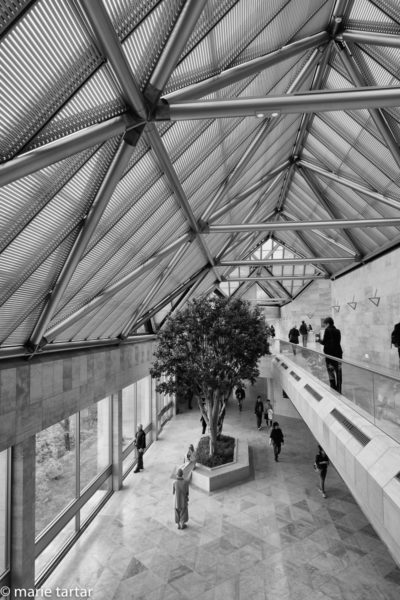
Deborah, MOPA director, at right, peers down at nuns below, while Steve at left (below) admires the forested landscape at the Miho Museum outside of Kyoto, Japan
This was the first really vibrant fall color we had seen so far this trip. We had a delicious lunch in Shigaraki at a family restaurant, Uosan, helmed by a 4th generation chef, at which the chef proudly showed off his Shigaraki clay-made sake flask, made by an artisan whose work he admired in a book written by Robert.
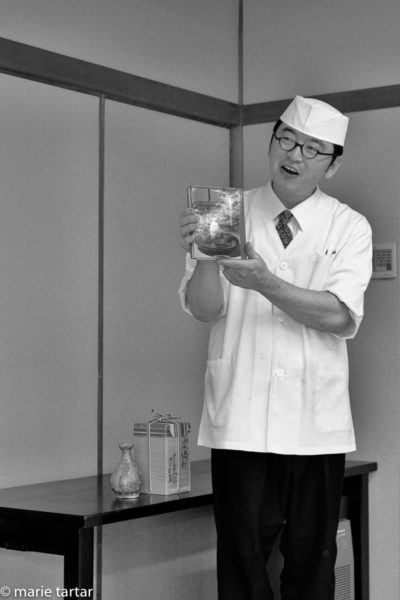
The 4th generation chef of family owned Shigaraki restaurant Uosan was inspired by Robert’s book (which he holds here) to acquire a sake vessel by one of the artisans Robert represents
We spent the afternoon visiting three elderly, but remarkably vibrant and active potters, who revived a traditional technique of the region and practice their craft by firing in tunnel kilns (anagama). The first, Kohyama Yasuhisa (born 1936), fed the kiln with wood with an energy inconsistent with his age of 80-ish.
His gallery presented his elegant contemporary sculptural works beautifully.
Many were tempting, but the steep prices required reflection.
The second, Kanzaki Shiho, rivaled the first in years, but used the fledspar inflected Shigaraki clay to achieve a more traditional result.
Koyama Kiyoko is a petite older woman who broke gender barriers in becoming an anagama potter in Shigaraki. She also stood her ground when the local municipality tried to dislodge her from her location at the foot of what became a ceramics showcase. When her only son developed leukemia, she became instrumental in the nascent establishment of bone marrow donation programs.
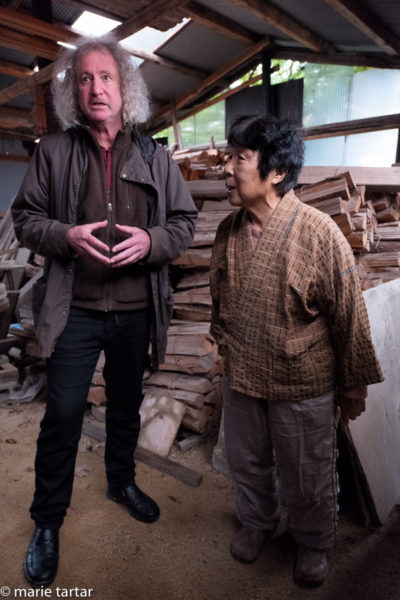
Petite Koyama Kiyoko is a force to be reckoned with, with Robert Yellin, contemporary Japanese ceramics dealer from Kyoto

Studio of Koyama Kiyoko, Shigaraki, Japan; somehow this seemed emblematic of the blood, sweat and tears that seemed part of this potter’s life
Our final stop as a group was at Robert’s Yakimono Gallery, where Steve and I yielded only to the lure of a tiny piece which brought a sea urchin to mind. It proved to be the work of a Shigaraki and Kyoto trained potter named Momoko Takeshita, now based in Ithaca, NY.
Most of the group headed down the street from Robert’s for an honorable noodle meal at O-men. Steve and I went to night -time illumination at Eikando Zenrin-ji Temple, at the south end of Philosopher’s Path, to which we walked in a soft rain, alone. The temple was also blissfully uncrowded, undoubtedly due to the persistent, but minimal rain.
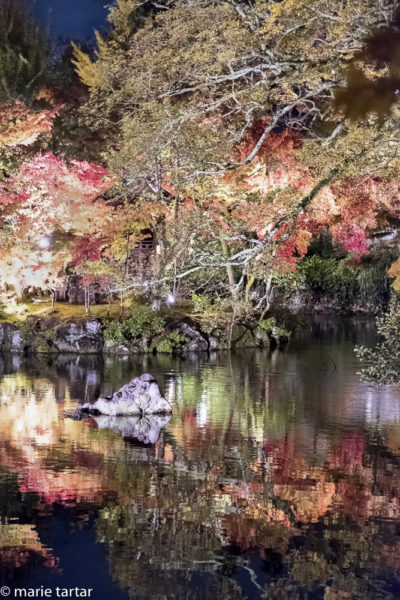
Autumn night-time illumination at Eikando Zenrin-ji Temple: It’s rare to have a garden to yourself in Kyoto, but a misty rain did the trick for us one magical night

Japan’s temples are always beautiful, but never more so than when lit up at night, a twice/year event, for cherry blossom viewing in spring and fall color in autumn
Wednesday, November 9, 2016
Election Day
Today was dedicated to Kyoto temples and World Heritage Sites, but quickly was dominated by the evolving news of the Presidential election at home. We’d previously met our guide for the day, Naomi Yamamoto, having spent a day with her on a prior trip to Kyoto, and having seen her for dinner with Ralph and Gail, when she subsequently visited San Diego. Poor Naomi had her work cut out for her with our group on this particular day. It started out well enough, at a Special Place of Scenic Beauty, the Golden Pavilion (Kinkaku-ji), probably the single most iconic sight of Kyoto.
As for the temple representing the Pure Land of Buddha? At least it is representative of Muromachi-period architecture. It was rainy and intermittently misting, varying from cool, crisp and sunny to frankly cold later in the day. At that point, she mostly had the group’s attention-there were no returns in yet. But as the morning progressed, and it became clearer and clearer what the outcome would be, the group’s collective mood became quite dark and increasingly subdued.
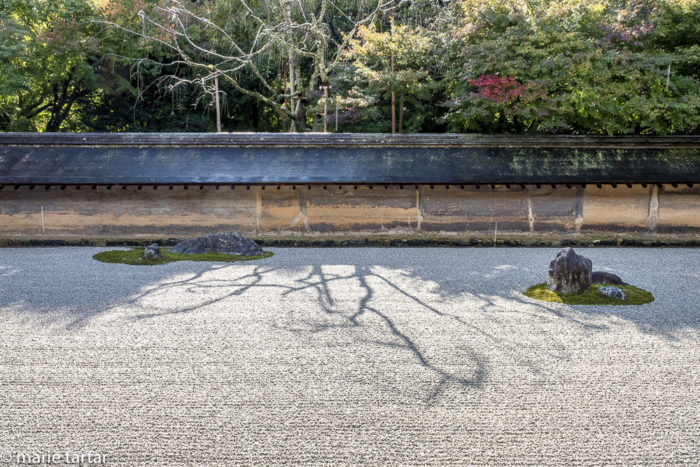
A slice of the famed zen rock garden of Ryoan-ji, Kyoto; swimming tiger cubs, islands in the ocean?; the meaning of the rock groupings is debated and subject to individual interpretation, which might just be the point; even who and when the garden was designed are not certain; a drawing from 1799 documents this arrangement, but many think the garden is centuries older
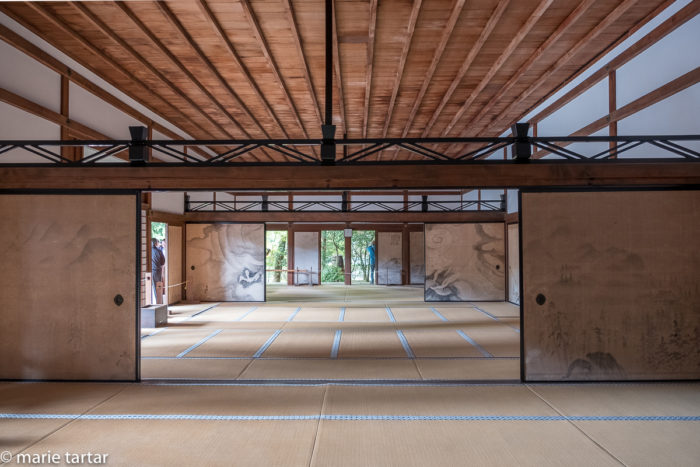
Beautiful buildings and gardens at Ryoan-ji, in addition to the famed rock garden; this is the Kuri, the main temple building
The stillness of Ryoan-ji, the famed zen Bhuddist rock garden and its lovely pond and grounds, should have been a comfort and a solace to the soul, but most of us had little attention for dates and statistics. Even Naomi’s silly but highly visible ladybug umbrella, although useful for seeing her from a distance in the garden, no longer elicited any smiles.
We had an excellent vegetarian Bhuddist lunch in a tatami room at Shigetsu restaurant at Tenryu-ji Temple. By this time, the news coming in was becoming alarming and we were facing the increasingly prospect of Stump emerging as the victor. Afterwards, we headed through the splendid garden to the north exit to the Arashiyama (arashi-thunder; yama-mountain) bamboo forest. I had suggested adding on the villa and garden of film star Okochi Sanso, and it was resplendent with autumn foliage.
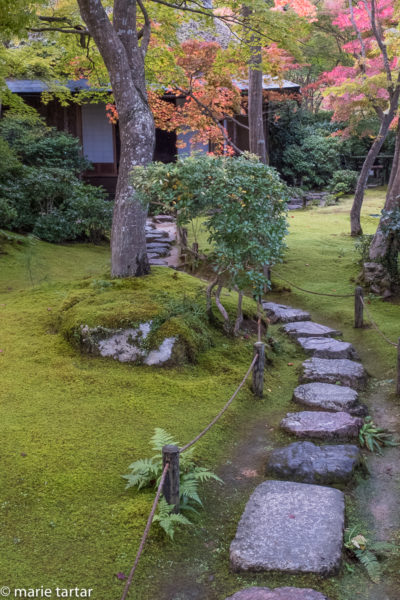
The most scenic villa in Kyoto? Perhaps…Okochi Sanso, the former home of a Japanese silent screen star
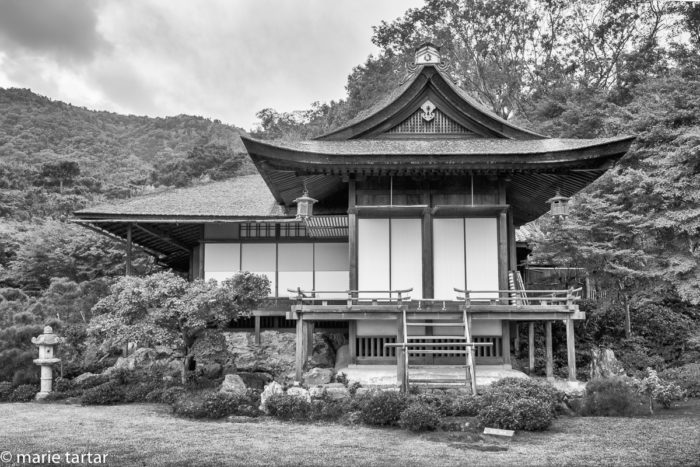
Traditional Japanese architecture, Okochi Sanso, the home of silent screen actor Okochi Denjiro (1898-1962)

The Okochi Sanso property is beautifully appointed with traditional architectural structures, including tea ceremony buildings
This was the villa of a silent film star, Okochi Denjiro (1898-1962), who had excellent taste in real estate! Situated on the south side of Mount Ogura, the property is worth the walk uphill, rewarding the climber with tea ceremony buildings, a transplendent garden and panoramic views of Kyoto.
By the time we headed to Nijo-jo Castle, the election results were all too clear and a distinct pall had fallen over the group, with reactions ranging from despair to anger to disbelief to depression. It had been more than 20 years since Steve and I toured the interior of the castle with Mama on our first trip to Japan in the early 1990s. The exterior was a delight at night, illuminated for hanami, flower viewing, during the bounteous cherry blossom season during our April 2016 visit.
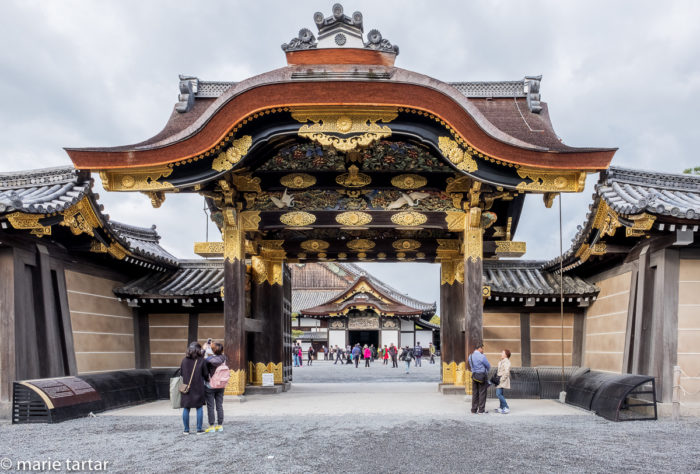
Nijo-jo, the Kyoto seat of power of the Tokugawa Shogunate (military warlords), who ruled Japan for centuries during the Edo period (1603-1867)
All I remembered was the nightingale floor, the specially rigged, early warning system designed to protect the shogun from attack. I had forgotten the lovely pine tree and peacock imagery, painted on gold leaf, in the reception rooms. The group decided to forego Heian Shrine, our last scheduled stop. Instead, we did a drive-by. By this time, it was a much reduced group, with people bailing early in twos and threes from Nijo-jo.
We were dropped off en route to the hotel, and to decompress, I fired up the auto-filling, wood ofuro bath for a long soak, while Steve headed out with his camera to do some street photography.
When he returned, we went to our local okinomiyaki joint, Issen Yoshoku, a Kyoto and Gion institution, with but a single item on their menu. Although okinomiyaki, means “as you like it”, at Issen Yoshoku, the signature item is served their way, cheap and delicious! On prior 2 stays in Kyoto, it had been our traditional first meal, and now, we were sorely in need of comfort food.
Steve headed home, while I caught a taxi for Kodai-ji Temple, lit up for fall.
It was awesome and succeeded in making me forget about the election for a while. I enjoyed it so much, I almost headed home then, but decided to cab it up to Shorenin Temple for their night-time illumination. It was more subtle and comparatively dim, except for the soaring bamboo forest. I had lugged a tripod along, but was rebuffed at both places from using it.
This final day in Kyoto was a strange and sad one. We took leave of the MOPA group on an extremely depressed note, but were on our way to Naoshima Island the following day. If any destination could pick up our spirits, this would be it…at least we had a really special accommodation in which to regroup. Here’s a preview:
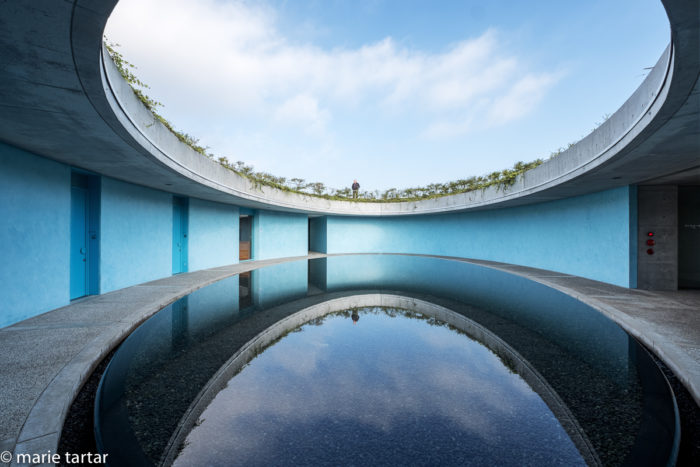
Ando-designed Oval hotel on Naoshima Island, by day, with Steve up on the living roof, a stellar experience, like living in your own James Turrell artwork
-Marie
P.S.: A kyoto restaurant recommendation from James for next time: http://www.kappou-yoshizen.com/
At long last, the final installment, magical Naoshima island, a splendid merge of nature, contemporary architecture and art:
https://aperturephotoarts.com/japan-november-2…ma-island-part-4/

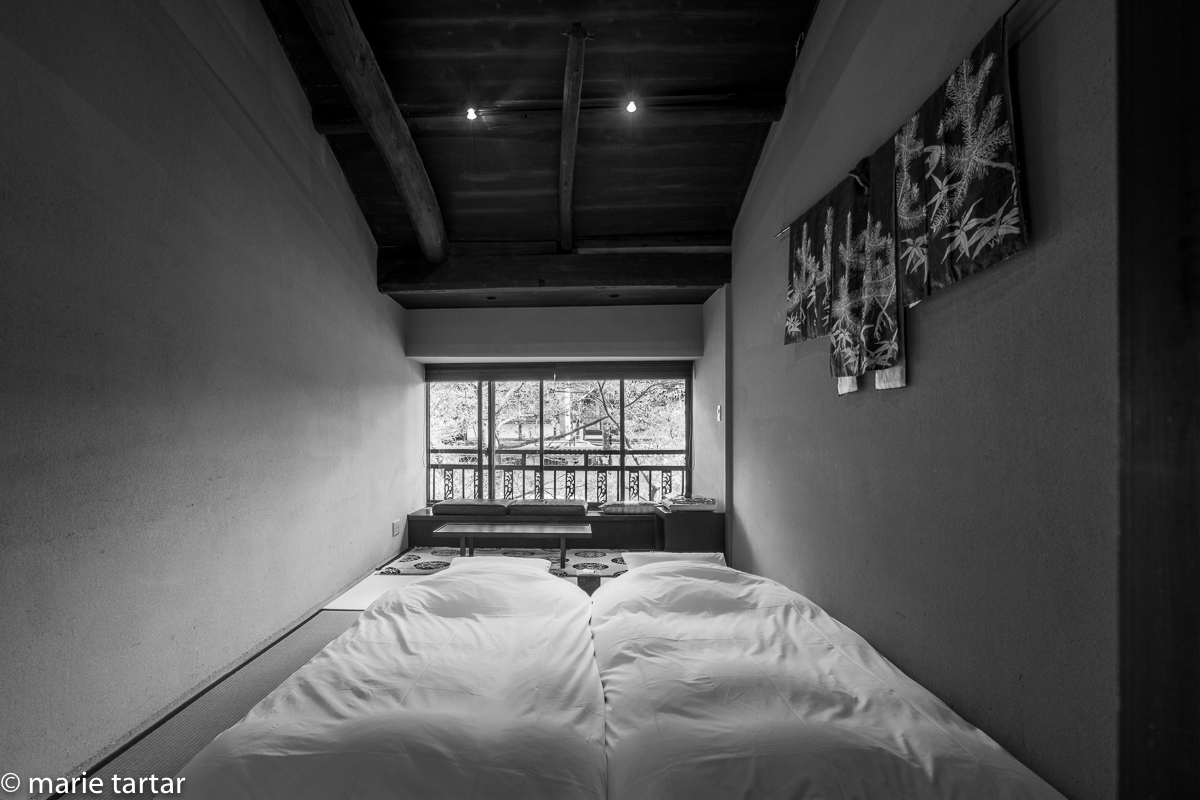

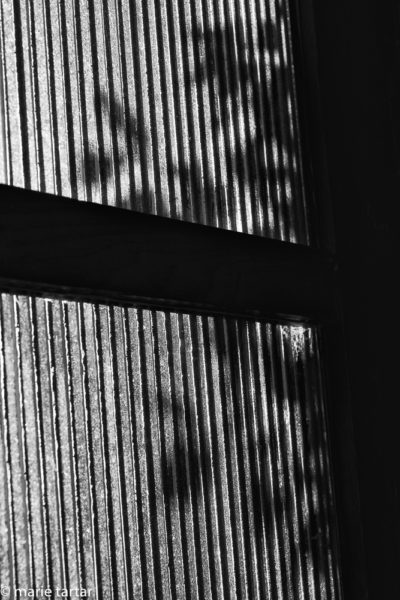


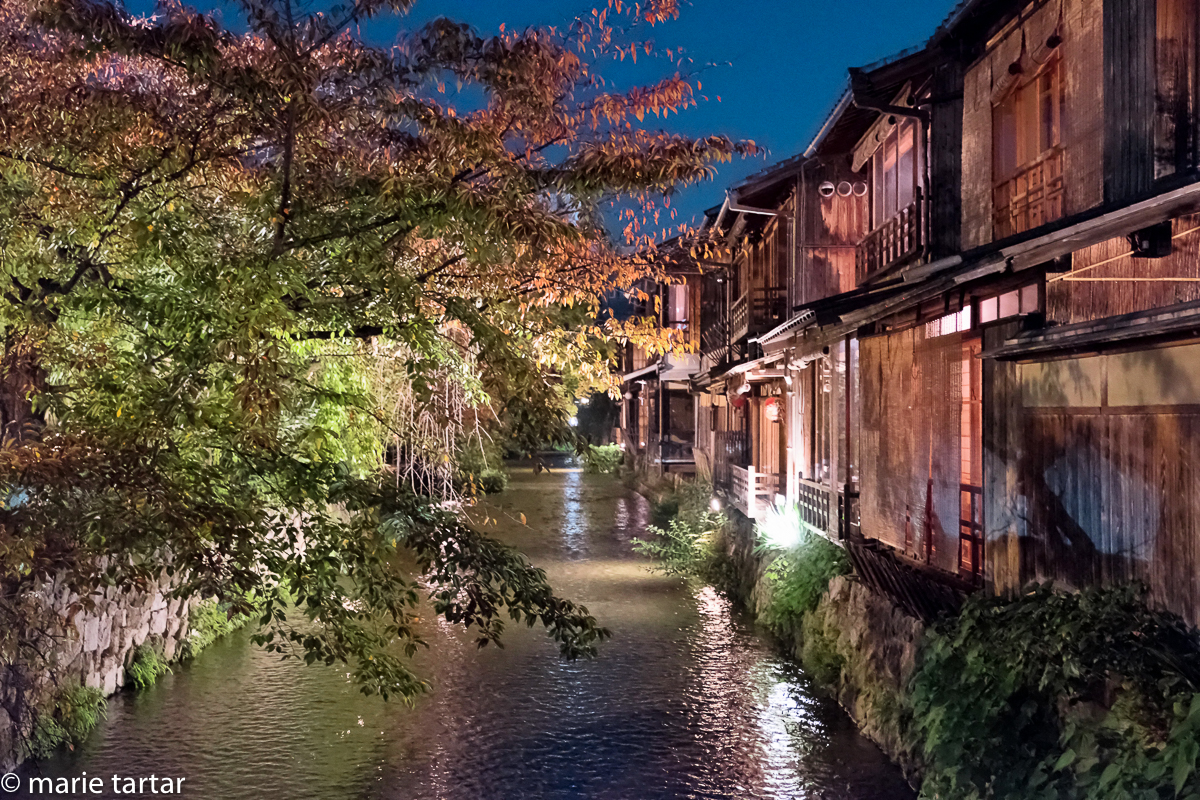
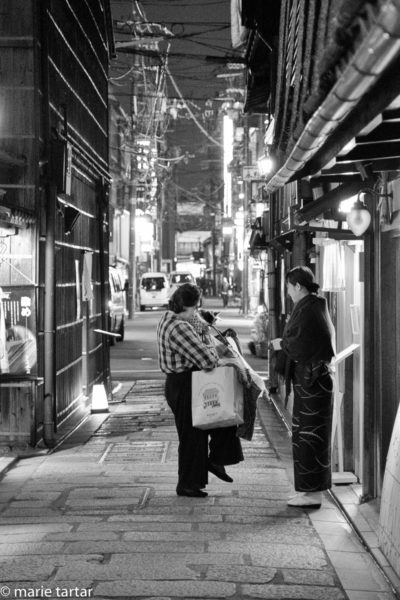
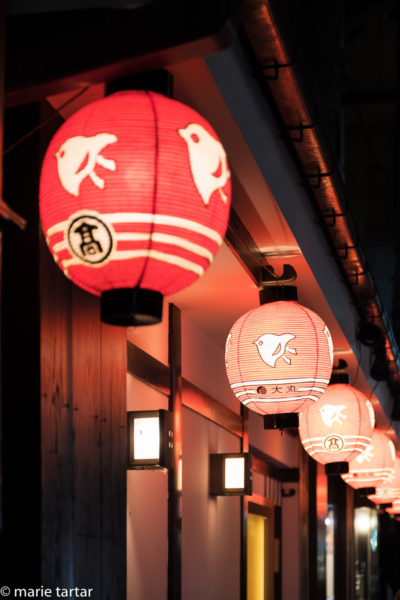


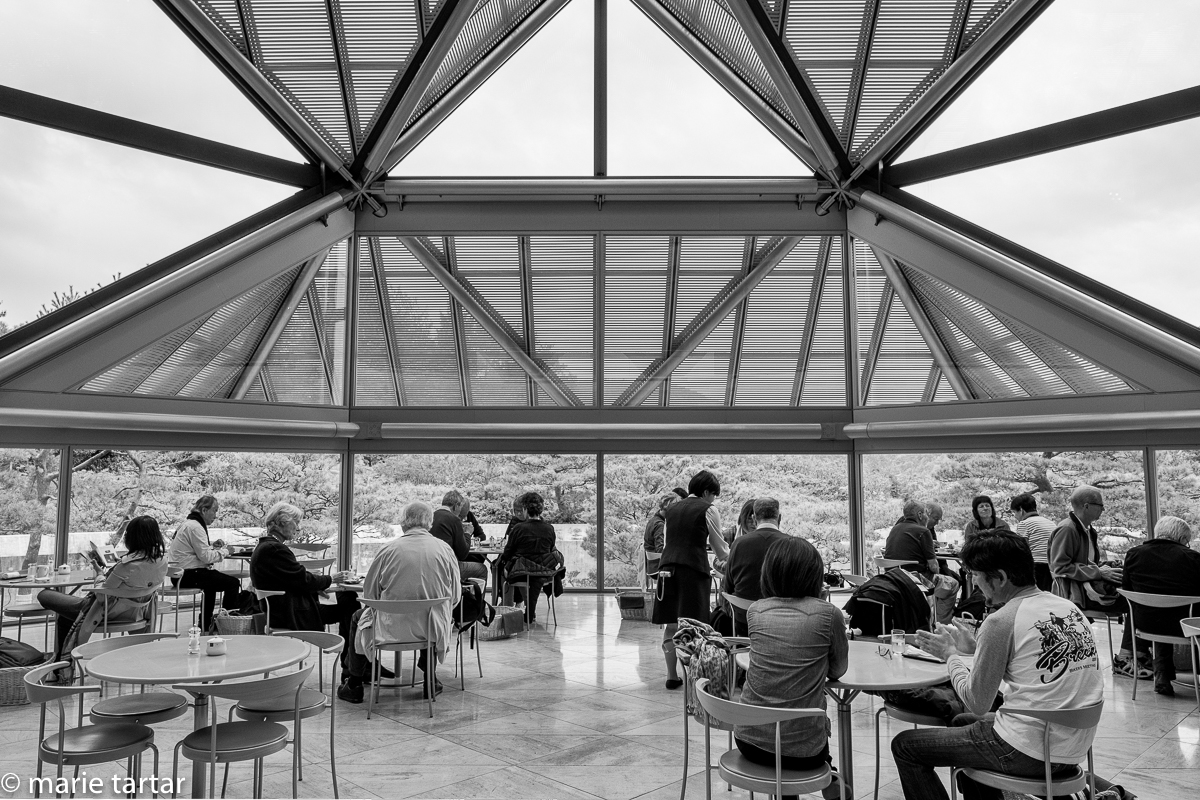
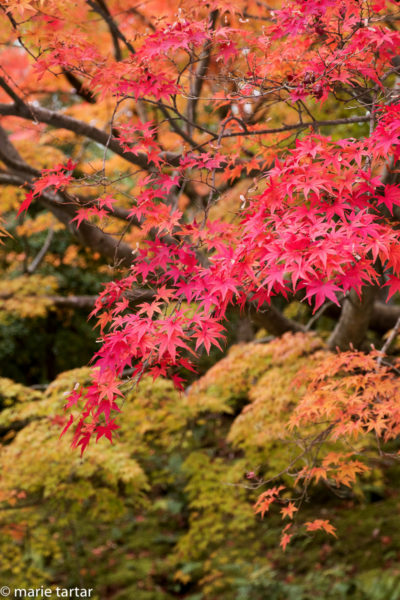

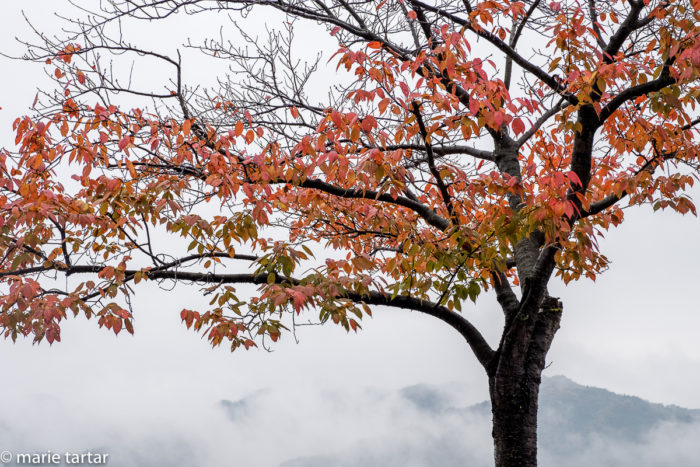
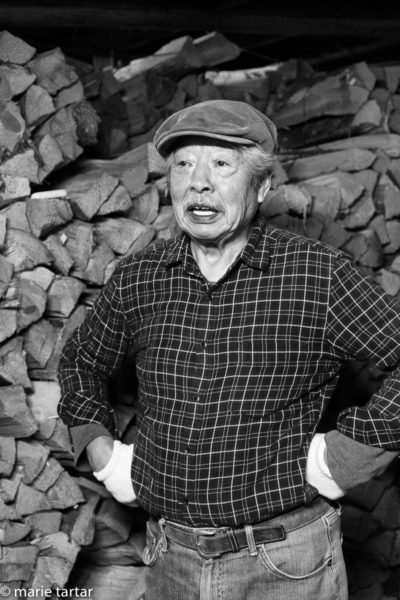

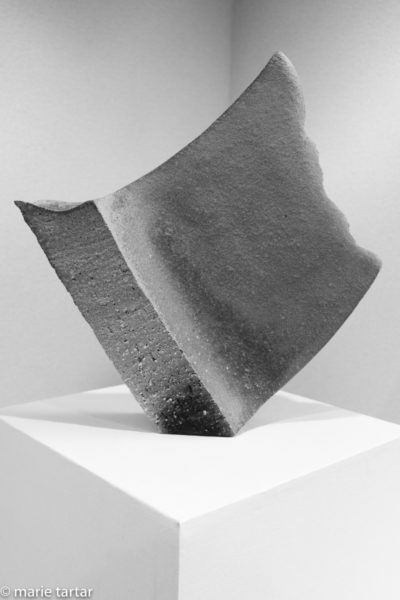

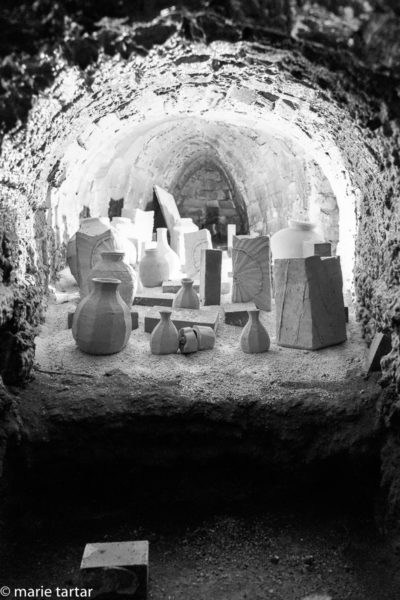

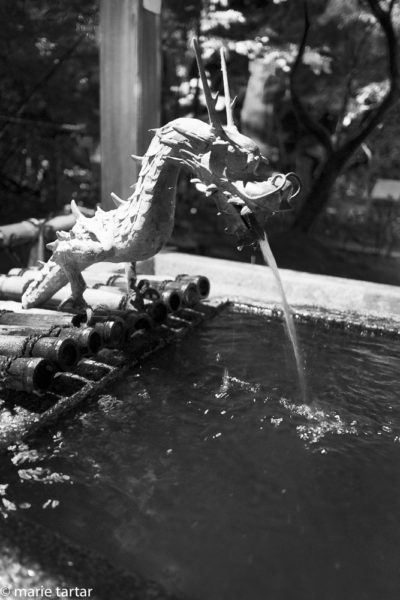

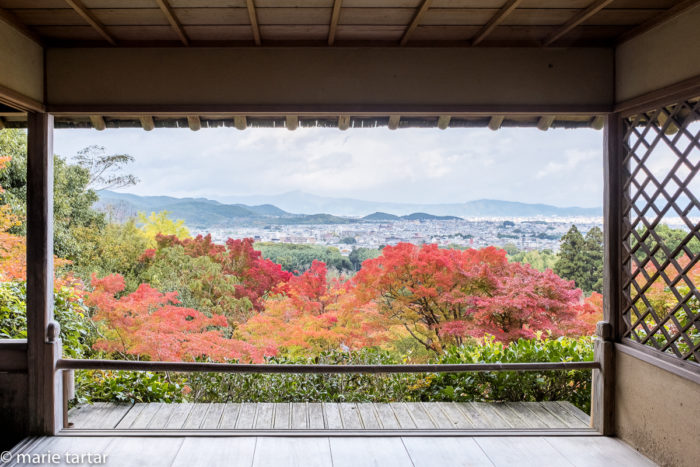
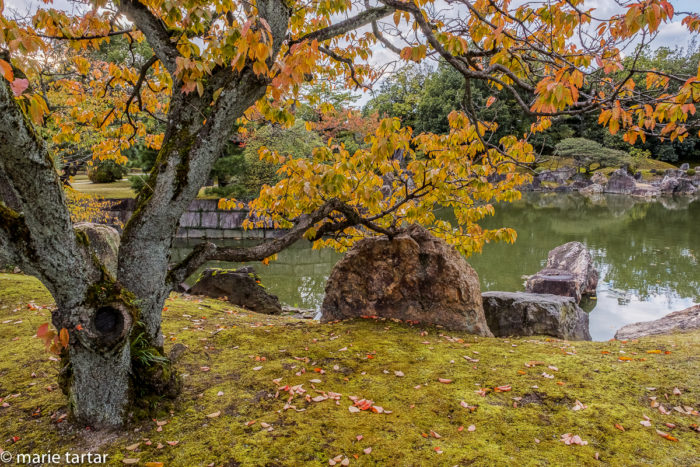
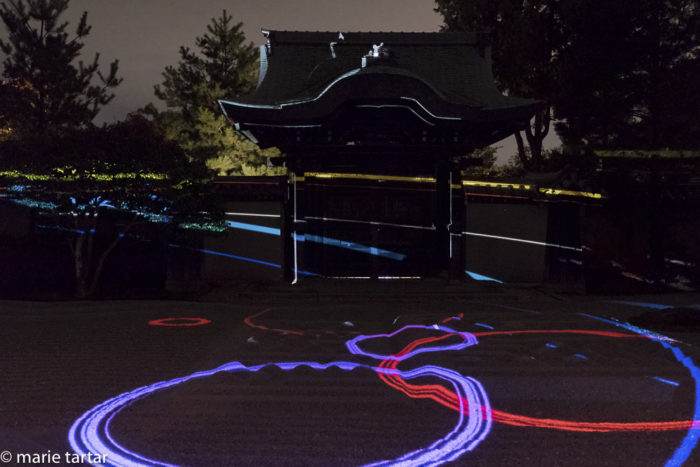

Some of your finest work, ever, and I should know. Seriously. The panoramic view of Potter’s Valley, Shigaraku, is just as I imagined scenery in writing When All Was Forgotten. Psychic.
Thanks, Joe, it was a great trip (with one notable exception that had nothing to do with Japan!).
-Marie
Beautiful photos. I love the Japanese esthetic (if there is one unifying element I would say organic or nature inspired) and you capture it well. I especially love the bamboo photo – it has a dynamic quality that pulls the viewer skyward while the illumination lends an air of mystery. Thank you for sharing.
Thanks for a great blog of your trip. We were in Kyoto at the same time, and upon learning of election news, had to cut short a visit to a museum because it no longer held interest, went back to our apartment, and opened a bottle of sake to drown our sorrows.
It’s always magical to travel with Robert Yellin. He’s now a dear friend. Love your photos.
Thanks for checking it out, Dianne! I think it was better being in Japan than at work during election day, but…it was not good. I like your strategy for coping!
Marie